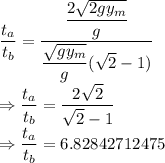
Physics, 13.02.2020 05:51, kolbehoneyman
In the vertical jump, an athlete starts from a crouch and jumps upward as high as possible. Even the best athletes spend little more than 1.00 s in the air (their ""hang time""). Treat the athlete as a particle and let [math]y_{\max }[/math] be his maximum height above the floor. To explain why he seems to hang in the air, calculate the ratio of the time he is above [math]y_{\max } / 2[/math] to the time it takes him to go from the floor to that height.

Answers: 3
Other questions on the subject: Physics

Physics, 22.06.2019 08:30, ahmedeldyame
Individuals who live below the poverty line get seriously ill more often than those who do not what could be the hidden variable in this situation?
Answers: 3

Physics, 22.06.2019 10:30, johnthienann58
The precision of a laboratory instrument is ± 0.05 g. the accepted value for your measurement is 7.92 g. which measurements are in the accepted range? check all that apply. 7.85 g 7.89 g 7.91 g 7.97 g 7.99 g
Answers: 1

Physics, 22.06.2019 21:30, carleygalloway103
Calculate the minimum energy required to remove one proton from the nucleus 126c. this is called the proton-removal energy. (hint: find the difference between the mass of a 126c nucleus and the mass of a proton plus the mass of the nucleus formed when a proton is removed from 126c.) express your answer with the appropriate units. emin e m i n = nothing nothing request answer part b how does the proton-removal energy for 126c compare to the binding energy per nucleon for 126c, calculated using eb=(zmh+nmn−azm)c2?
Answers: 1
Do you know the correct answer?
In the vertical jump, an athlete starts from a crouch and jumps upward as high as possible. Even the...
Questions in other subjects:

Mathematics, 26.01.2021 02:30


History, 26.01.2021 02:40



English, 26.01.2021 02:40



Geography, 26.01.2021 02:40

Social Studies, 26.01.2021 02:40












